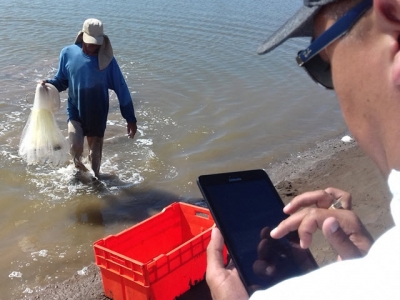iQShrimp: Cloud-based, predictive software for shrimp farmers

New app provides live operational dashboard for better decision-making
The iQShrimp system centralizes pertinent data and information from shrimp ponds and their surroundings, combining production and environmental information into a live operations dashboard that provides recommendations on critical pond-management decisions. Photo by Régis Bador.
Shrimp farming has many internal and external risk factors that can be overcome if the right information is in hand at the right time.
Cargill’s iQShrimp is a digital platform designed to help shrimp farmers make better decisions and manage their risk. It uses machine learning and various commercially-available sensors to provide users with real-time visibility into the operation of their farms, and is a first-generation offering driven by iQuatic™, the company’s digital platform for aquaculture.
“Machine learning technology is a form of artificial intelligence that applies statistics to large data sets, along with modern computing power to identify trends that are not easily identified by the human eye,” said Benjamin Allinder, iQuatic development team leader. “Machine learning models are then trained to take into consideration all types of factors to predict an outcome. iQShrimp uses this technology to focus on answering questions such as what is the current total biomass in the pond, as well as what is it projected to be? This will give farmers even more information to make critical feeding and harvesting decisions.”
iQuatic™ captures data from shrimp ponds through mobile devices, commercial sensors and automated feeders and records many relevant information such as shrimp size, various water quality parameters, feeding patterns, health and relevant weather conditions.
The system centralizes all pertinent data and information from the ponds, the farm and its surroundings, combining production and environmental information – generated by pond workers who can now enter data through a tablet or smartphone directly from the pond. Data is then automatically uploaded to a live operations dashboard that provides recommendations like feeding management strategies and optimal harvest dates. The app eliminates paper, hand-calculation errors and delays in sharing data.
“Shrimp farming has inherent weather and disease risks,” said Neil Wendover, Cargill’s digital insights director for aquaculture. “By working directly with shrimp farmers, our data scientists can use machine learning to deliver insights to inform decisions that directly impact the growth and economics of their operations.”
When the user’s tablet or smartphone connects to Wi-Fi (wireless local area networking) or GSM (Global System for Mobile Communications), pertinent data that had been stored on the handheld device are immediately sent to the cloud and become available for authorized staff, who can monitor the data online.
Other sources of data that can be accessed and used by the farmer include any connected device, such as various commercial sensors, feeders, aerators, pumps and other equipment that can send updated measurements in real time.
The iQuatic team has also included weather forecasts and can update local shrimp price lists from cooperating processors.
iQShrimp centralizes this data into a dashboard that tracks water quality, weekly growth, feed consumption, biomass estimation and more. It uses smart color codes so that any critical situation will be more visible and catch the user’s immediate attention, who can then immediately apply any necessary corrections and adjustments without having to wait for the data report, which can take one to three days.
The system can also analyze historical data to build several models, including growth, feed consumption and survival models, to help make production predictions and to optimize harvest times and maximize profit. The iQuatic team can enter decades of data (stored so far in any file format) and analyze past strategies. The machine-learning process included supports the continuous improvement of the prediction models from both historical and real-time data.
The software stores the farm data, which remains the property of the farmer, and incorporates it to the database anonymously. Neither Cargill Digital Insights nor iQShrimp will share personal farmer data unless agreed by the farmer.
The system also includes the guidance of “digital transition champions” on site to help train farm workers, technicians and biologists on the daily use of the software, for up to a full production cycle.
The cost of the customizable technology – available through a monthly or yearly subscription – is based on the number and size of ponds. It is currently available for producers in Mexico, Central America, Ecuador, New Caledonia, Southeast Asia and India, and will expand to other geographies soon.
“Through cloud-based solutions and technology investments, our aspiration is to help lead the digital transformation of the aquaculture industry. We believe nothing can replace experience and biology however the future is a connected farm with faster, more informed decision making and ultimately that will mitigate risk and improve productivity,” said Wendover.
Có thể bạn quan tâm
 What is a “biofloc" System?
What is a “biofloc" System? Biofloc aquaculture is a recirculating, highly aerated, closed-loop pond system that produces high volumes of shrimp while using fewer resources than convention
 Rainy season effects on shrimp grow-out ponds (Part 1)
Rainy season effects on shrimp grow-out ponds (Part 1) In this article (adapted and summarized from the original publication in Revista Acuacultura – Cámara Nacional de Acuacultura, No. 122, April 2018)
 Shrimp farming industry in Ecuador, part 1
Shrimp farming industry in Ecuador, part 1 Shrimp farming began in Ecuador almost 50 years ago in a casual manner. The first shrimp farms were established in the southern part of the country